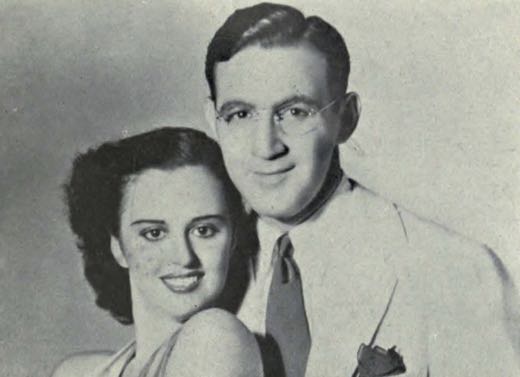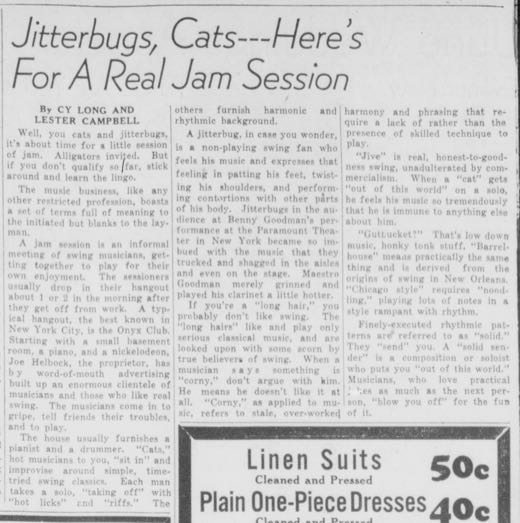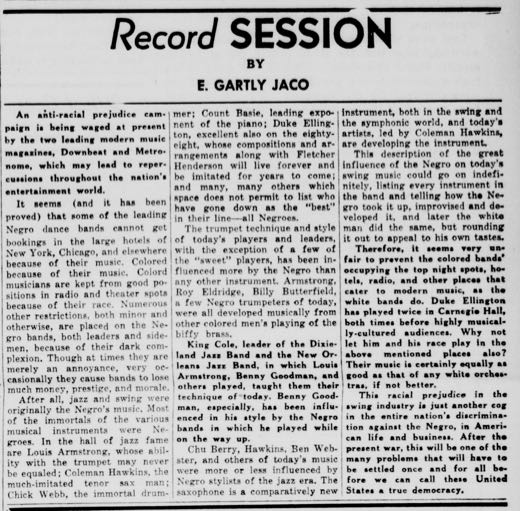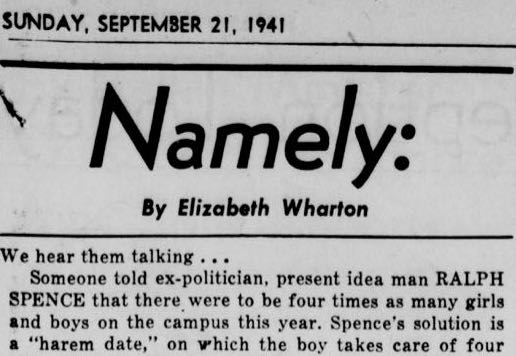Swing in Austin
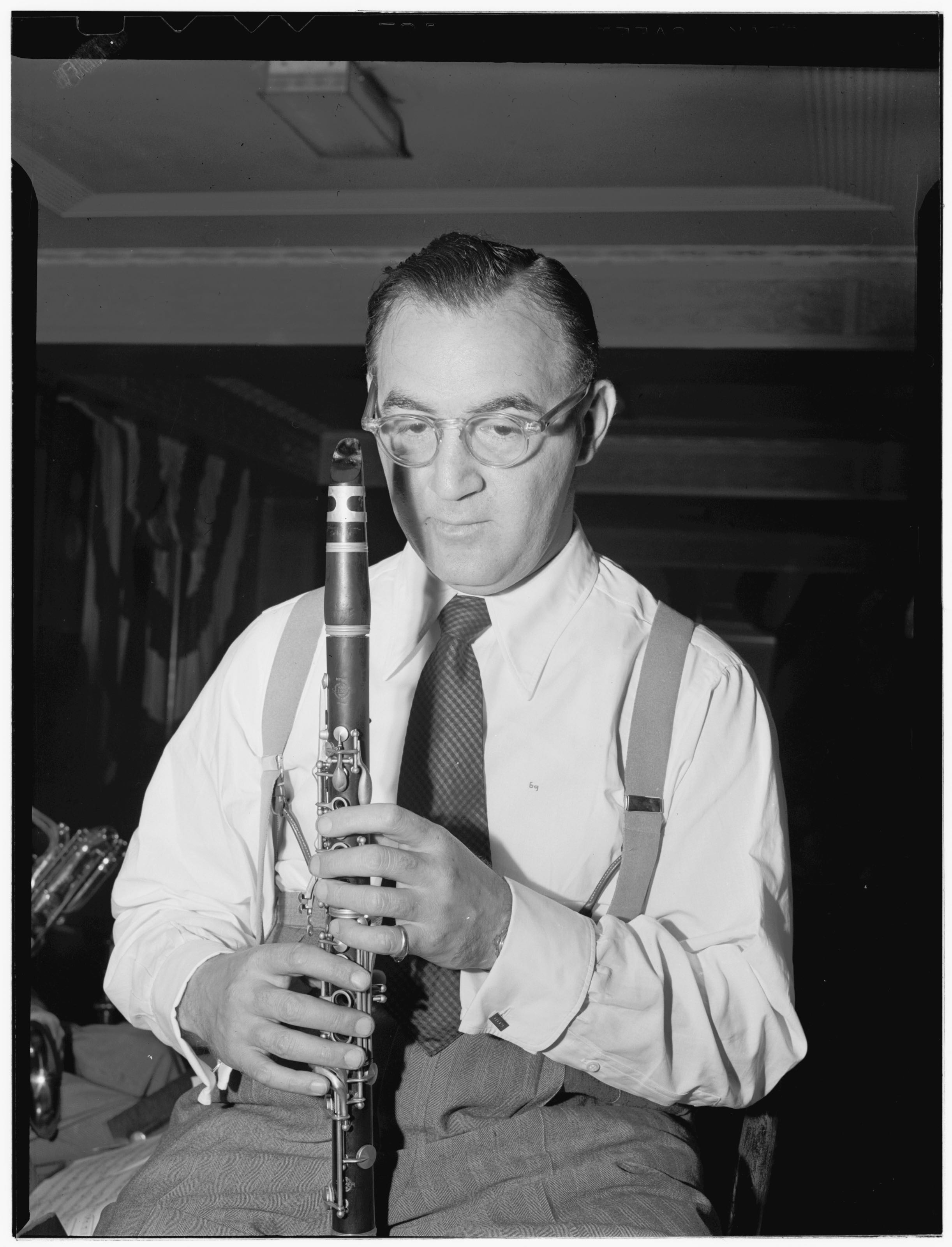
William P. Gottlieb. Portrait of Benny Goodman, 400 Restaurant, New York, N.Y., ca. July. United States, 1946.
Thus, Austinites were some of the earliest participants in the national Swing phenomenon and his 1935 UT concerts were some of its earliest events. Despite being one of its pioneering audiences, it took some time for the more intense rhythms of Swing to garner wide spread enthusiasm amongst the university population. When Goodman played at UT, his two performances went “relatively unnoticed by the student population.”1 Within a few years, however, Swing had a significant following at the university. In February 1938, a poll of 500 students ranked Goodman’s band as the most popular orchestra at UT.2
The Democratic Culture of Swing
Many historians have identified Swing as an essential cultural expression of the New Deal. Lewis Erenberg claimes that Swing culture “mirrored a new optimism about democratic culture, an appreciation of ethnic and racial pluralism, and a delight in the utopian promise of urban life. For a variety of fans in the 1930s and 1940s, dreams of new sexual relationships and new American identities came together in the throes of jitterbug dance.”4 Swing recognized African American musicians and dancers as central to the mainstream culture of the United States for possibly the first time, something that had been denied to them in the past despite their critical contributions. “Hot” rhythms and improvisation—which had been tied closely to black musical culture since the late 19th century—were celebrated and placed at the fore, even if white bandleaders still received the greatest amount of prestige and cash.
Many prominent critics, most notably the New York music impresario John Hammond, directly tied themselves to the progressive politics of the New Deal Popular Front. They advocated against racism in the music industry and argued that jazz and Swing were a people’s music. Big Bands, they passionately contended, represented the values and culture of everyday people, the hard-working laborers and folk artists who comprised America.5
Swing bands had begun to integrate over the course of the 1930s and early 1940s, a major achievement in the de-segregation of popular culture. The most famous example was the appearance of pianist Teddy Wilson (born in Austin) and vibraphonist Lionel Hampton in Benny Goodman’s small groups in 1935 was pivotal, but other bandleaders, like Artie Shaw , Fletcher Henderson, Earl Hines , Gene Krupa, and Charlie Barnett also hired mixed bands.
Although the pluralism of people like Jaco certainly existed in Austin, the local democratic culture of Swing in Austin was structurally limited by race. A segregated institution in Jim Crow Texas, UT barred African Americans from entering and attending. Thus, the utopian democracy envisioned by UT students at dances was largely meant to be between whites, not across the color line. For the dances, the only blacks present were on the bandstand or university porters. Furthermore, other musical performances held in the Union and Gregory were explicitly racist, like the annual Cowboy Minstrel show, which featured students from this organization in blackface.
Swing vs. Sweet
The Musical Versatility of Swing and Dance Bands
Focusing on the popularity of Count Basie vs. Kay Kyser can obscure the wider, more varied kind of music that was typical at All University Dances. “Sweet” and “Swing” should not be seen as two separate and widely different types of music. Musically, they had a great deal in common and they both shared the same origin: they both developed out of the same pop orchestra tradition centered around Paul Whiteman and Fletcher Henderson during the 1920s. It’s more accurate to see them as two ends of a dance orchestra spectrum. Some bands played mostly in one of these styles and were identified as “swing” or “sweet” bands. But many groups fell somewhere more in the middle, seeing them as different styles of songs that a band could incorporate into their act for variety instead of as a fundamental musical identity.
This versatility was a major part of the popular music profession in the first half of the twentieth century. When ragtime was a national phenomenon from the 1890s to the 1910s, dance orchestras and brass bands had to play it alongside whatever other types of dance music were popular at the time: foxtrots, waltzes, tangos, rhumbas, etc. Being able to play different types of music for different types of dances and different types of audiences was a sign of professionalism in the music industry. Bands had to accommodate the tastes of different listeners, depending on what part of the country they were playing and the composition of their audience. Thus, dance bands played all sorts of dance music; swing and jitterbug numbers were just one type.
For Texas as a whole, versatility was a requirement for playing for different cultural communities. If you played for an African American audience one night, an Anglo one the next, then a university gym or a working class dance hall, you needed to be able to play different music for each. Don Albert , probably the most well known jazz and Swing bandleader in Texas in the mid-to-late 1930s, explained that
Notes
- The Cactus: Yearbook of the University of Texas (Austin: Texas Student Publications, 1938. ⏎
- “Benny Goodman is Favorite at University,” Daily Texan (February 20, 1938). ⏎
- “Ten Dancers Chosen for Radio Show,” The Daily Texan (March 23, 1938); “Big Apple, Swing May 13 Help Build Tillotson Gym,” The Daily Texan (May 6, 1938). ⏎
- Erenberg, Swingin’ the Dream, xvi. ⏎
- Lewis Erenberg, Swingin’ the Dream: Big Band Jazz and the Rebirth of American Culture (Chicago: University of Chicago Press, 1998; David Stowe, Swing Changes: Big Band Jazz in New Deal America (Cambridge, MA: Harvard University Press, 1996). ⏎
- J. Gartly Jaco, “Record Session” Daily Texan (May 13, 1943). ⏎
- “Basie Records Most Popular,” Daily Texan (May 14, 1944). ⏎
- Daily Texan (April 27, 1938); Daily Texan (March 1, 1941); Daily Texan (March 3, 1938); Daily Texan (November 28, 1934); Daily Texan (April 4, 1941). ⏎
- Interview with Don Albert, May 5, 1972. ⏎
